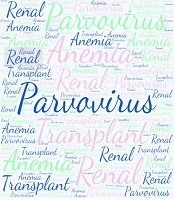1. Introduction
Parvovirus is one of the uncommon causes of anemia in a kidney transplant patient (1). Post-transplant anemia occurs in 25 to 50% of patients (2). In this study, we reported a kidney transplant patient with parvovirus infection who developed severe anemia with renal failure despite treatment with a therapeutic level of immunosuppressive drugs.
2. Case Presentation
The patient was a 20-year-old man with a history of renal failure in the field of glomerulonephritis who underwent a kidney transplant from a deceased donor on 5 July 2019. Induction treatment with anti-thymocyte globulin (ATG) 3 mg/kg and five courses of methylprednisolone pulse were done. Two weeks after renal transplant, kidney biopsy was taken because of creatinine 1.9 and pathologic finding acute tubular injury and mild interstitial inflammation. The patient was discharged with maintenance immunosuppressive therapy, including tacrolimus 4 mg/d and mayfrotic1.5 gr per day and prednisolone with creatinine 1.29.
Tacrolimus level was 5.9 to 12. Four weeks after transplantation, he was hospitalized due to shortness of breath, fatigue, weakness, and palpitations. The patient's vital signs were PR = 100/min, RR = 15/min, BP = 100/60 mmHg, and T = 37°C.
Laboratory findings showed: WBC = 14300/µL, hemoglobin = 5.6 g/dL, hematocrit = 17%, RBC = 2.08/µL, MCV = 81.7, PLT = 32000, BUN = 24 mg/dL, Cr = 1.5 mg/dL, iron = 177 µg/dL, TIBC = 259 mg/dL, ferritin = 1650 µg/L, LDH = 1751 µ/L, retic = 2.5%, Bk virus PCR = negative, CMV virus PCR = negative, parvovirus B19, PCR = positive.
Ultrasound result of the transplanted kidney showed: 56 × 65 × 123 mm kidney with normal echo and thickness, mild hydronephrosis in the transplanted kidney, and RI of segmental arteries was = 0.58 - 0.64. The patient received three courses of 45 g IVIG that creatinine decreased to 1.2 and anemia was improved.
3. Discussion
This is one of the rare cases of kidney transplantation and parvovirus infection with severe and progressive anemia with graft failure three weeks after kidney transplantation. The patient's anemia was not in favor of hemolysis gastrointestinal or urinary bleeding, or malnutrition. Suspicion of infections increased due to the decrease in erythrocyte level. Erythrocyte-involving infections, including parvovirus, were suspected. The patient's anemia became normal with a decrease in the amount of immunosuppressant and treatment with IVIG. A study between 1990 to 2005 evaluated 98 transplant patients (bone marrow, kidney, etc.) who had anemia and infection with parvovirus B19, six kidney transplant patients had parvovirus infection and anemia. The median time from transplantation to parvovirus development was 1.5 months. Anemia was seen in all six patients, and transplanted kidney dysfunction was seen in only one patient (3). All patients received IVIG for two doses of 0.5 to 1 g/day. Anemia resolved in all patients. In this 16-year follow-up study, the presence of seven cases of parvovirus indicates that the infection is rare, however, in this study, it should be noted that none of the 47 transplant patients who had anemia for about 23 weeks were evaluated for parvovirus, which indicates that parvovirus is less considered in transplant patients with anemia (3).
In a review of 144 kidney transplant patients from 2007 to 2013 by Krishnan et al, two percent (three subjects) had parvovirus infection. Two of them had kidney failure with anemia, and the average time of transplantation until the infection was 8.6 weeks. Kidney failure and anemia were eliminated by treatment with parvovirus infection (4).
The most common clinical manifestations of parvovirus in immunocompromised patients are arthralgia fever and anemia rash, and lack of response to erythropoietin (5). Parvovirus can be accompanied by hepatitis, myocarditis, pneumonitis, and graft dysfunction in transplant patients (3), as in our patient. A case of cardiogenic shock in parvovirus has also been reported (6). The disease is diagnosed by serology and PCR by showing the virus directly in the blood. Serological tests at the onset of the disease may be negative.
In case of negative PCR and strong diagnostic doubt, bone marrow sampling is recommended (3). Treatment strategy of parvovirus infection is to reduce the dose of immunosuppressant and IVIG 400 mg/kg per day for five days (7-9).
3.1. Conclusion
High suspicion for parvovirus infection in kidney transplant patients with severe anemia and allograft failure should be considered. In the early stages, anemia is diagnosed by PCR testing, which is a safe and non-invasive method.
